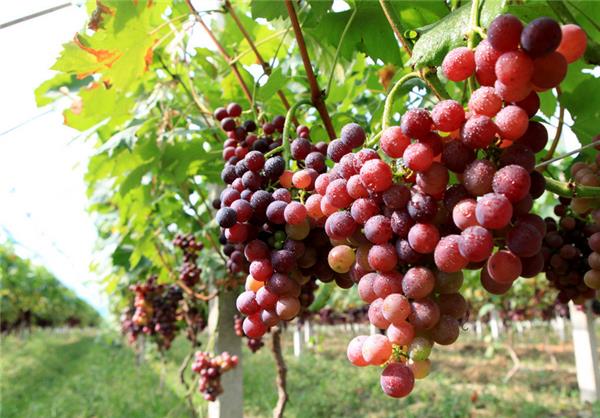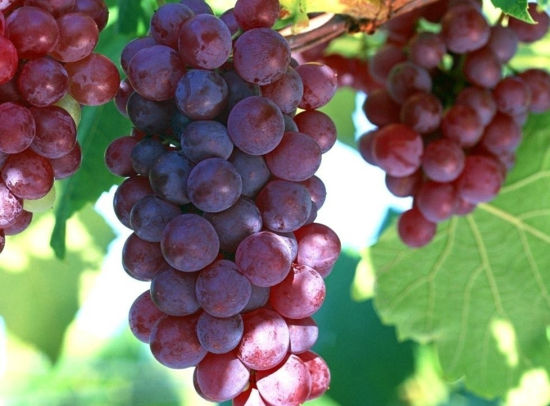Cultivation techniques of grape
Grape growing in the southern region is affected by high temperature, humidity and plum rain during the growing season, resulting in serious diseases and insect pests, especially infectious ☆ banning ☆ diseases, which is difficult to control, which leads to the destruction of some vineyards. Therefore, disease is the main factor restricting grape production in southern China. On the other hand, the southern region has the climatic characteristics of early temperature in spring, and the time when grapes begin to sprout and grow is more than 20-60 days earlier than that in the north, which is extremely beneficial to the development of early-maturing grapes, and the same variety is also earlier than that in the north. Its products can "fill the gap and avoid prosperity" and stagger the sales during the peak period on the market, which can not only supplement the lack of fresh fruit in the market, but also help to give full play to the planting benefits. So what are the cultivation techniques of grapes?

Cultivation techniques of grape
1: this variety has the advantages of early maturity, high quality, disease resistance, high yield and good storage and transportation resistance. Xiahei is a triploid variety, the natural growth of the fruit is small, so it needs to be treated with gibberellin, and the fruit can be increased by more than twice as much. Sufficient experiments should be carried out in various places in the treatment concentration and time, so as to sum up the safe treatment concentration and method. Summer black ripens early and is not easy to drop fruit, so it is suitable for promoting cultivation in facilities. The choice of rack type varies from place to place. Hedges are mostly used in the north and V-shaped or scaffolding in the south. Summer black grapes can be of any kind. The author advocates hedgerow cultivation, natural fan-shaped pruning, row spacing 1.7m, plant spacing 0.8m 667 square meters to plant 500 plants. In the area where the soil is needed to prevent cold, 420 plants can be planted with a row spacing of 2m and a plant spacing of 0.8m per square meter. Where there is a lot of rain, the first wire above the ground is more than 80cm away from the ground to prevent rain splashing and sediment pollution. This type of frame is beneficial to make full use of land, wind and light, especially for early high yield and general management level. In the second year, the output of 667 square meters can reach more than 2000kg.
2: trimming ear and thinning fruit, summer black grape ear neat, mostly without discernible shoulder, individual double ear. It is suggested that if there are two ears, one should be repaired. If the ear is too long, the ear tip should be removed 10 days before flowering. On average, there is only one ear per fruiting branch, and in practice, according to the principle of "strong two and one weak", that is, two ears can be left on the top (front end) of the shelf, one ear on the medium growth shoot, and no ear on the weak branch and culture branch. The total number of ears left is about 4000 per 667m2.

The seeds of summer black fruit are closely planted, so it is recommended that the fruit be thinned. Artificial fruit thinning, time-consuming, can be in full bloom fruit-setting period to drink water, or combined with fungicides, consciously spray the ear to promote its moderate drop. Or shake or hit the tree moderately during the flowering and fruit setting period, which can also play the role of thinning flowers and fruits.
3: expansion treatment at present, large grape is still preferred in the domestic grape market. The enlargement of the fruit is beneficial to increase the yield and improve the commodity value. Xiahei grape grows naturally and the fruit is small, which is the commonness of seedless grapes, so it is recommended to carry out expansion treatment. That is, 15 days after flowering, 45~50mg/kg gibberellin solution was dipped or sprayed on the ear, and repeated every 12 to 15 days. Or when the grains of soybeans are large, use 45mg/kg gibberellin solution to spray or dip in the ear for each 1~1.5kg to increase the yield of 10ml (inhibiting pedicel hardener).
4: fruit bagging grape bagging has many benefits, such as disease prevention, pest prevention, bird pest prevention, pollution prevention, yield protection and quality protection. The berries produced are not only beautiful, but also taste good. It is suggested that whether it is field production or greenhouse cultivation, strive for a full set of bags.

Matters needing attention of irrigation water in the cultivation of summer black grape
Xiahei grape is more tolerant to drought, but if it can be irrigated in a suitable period, the yield can be significantly increased. Points for attention of irrigation water in summer black grape planting:
Before flowering, we should pay attention to keep the soil moist. If it can be irrigated with topdressing, it can create good fertilizer and water conditions for flowering and fruit setting.
But summer black grape blossoms too much water, will cause a large number of flowers and fruits, unless the soil is too dry, otherwise the flowering period should not be watered.
Xiahei grape fruit setting to the fruit before coloring, is a high temperature, leaf transpiration, need a lot of water, can be irrigated every 7-10 days according to the weather.
After the fruit of summer black is colored and softens, it is generally not watered in especially dry years, too much watering will reduce the sugar content of the fruit and is not resistant to storage and easy to crack.
During the dormancy period of Xiahei grape, the soil is too dry and unfavorable for overwintering, and it is easy to cause mildew and rot of bud eyes. generally, it is permeable once in combination with fertilization in autumn after harvest, and frozen water is also irrigated before cold prevention in northern producing areas, which is an important measure to prevent cold in Xiahei grape.

Application methods and matters needing attention of rare earth elements in grape planting the application methods of rare earth elements in grapes are as follows:
Rare earth elements (re) refer to 15 heavy metal elements such as cerium praseodymium neodymium and ytterbium which are very similar in chemical properties of lanthanide elements in the periodic table. They are widely used in fruit trees in recent years. Commercial rare earth micro-fertilizer is called agricultural prophytin, referred to as "Nongle". Spraying rare earth elements on grapes can increase fruit setting rate, leaf area, chlorophyll content, photosynthetic capacity and dry matter accumulation, so as to effectively increase yield and quality. It can also effectively prevent fruit cracking and promote fruit ripening.
Before flowering, full flowering and fruit expansion, the grapes were sprayed with 1000 mg / kg of rare earth elements. Practice shows that after this treatment, the yield can be increased by 10%, the sugar content can be increased by 1%, and the maturity can be advanced by 5% and 7 days.

For some varieties which are easy to crack fruit, such as Zhana, Rizamat, Jingyou and so on, spraying 500 mg / kg rare earth elements twice during fruit expansion can make the pericarp thicker and reduce fruit cracking accordingly.
In the use of rare earth micro-fertilizer, it should be noted that ① rare earth fertilizer can only be dissolved in slightly acidic solution, and it is easy to form precipitation in hard water and alkaline solution, so when preparing, you should first use vinegar to adjust the water to slightly acidic (p5mur6), then add rare earth micro-fertilizer, stir it fully, and then mix it into the required concentration after it is completely dissolved for use. ② rare earth micro-fertilizer should be sprayed after 9: 10 a.m. and 16:00 in sunny days. The concentration of rare earth micro-fertilizer sprayed on the leaf of ③ must not exceed 1%, otherwise it is easy to cause drug damage. ④ rare earth microfertilizer had obvious effect on vineyards planted in sandy soil and calcareous soil, but had no obvious effect on acid soil.
Application methods and matters needing attention of rare earth elements in grape planting the application methods of rare earth elements in grapes are as follows:
Rare earth elements (re) refer to 15 heavy metal elements such as cerium praseodymium neodymium and ytterbium which are very similar in chemical properties of lanthanide elements in the periodic table. They are widely used in fruit trees in recent years. Commercial rare earth micro-fertilizer is called agricultural prophytin, referred to as "Nongle". Spraying rare earth elements on grapes can increase fruit setting rate, leaf area, chlorophyll content, photosynthetic capacity and dry matter accumulation, so as to effectively increase yield and quality. It can also effectively prevent fruit cracking and promote fruit ripening.
Before flowering, full flowering and fruit expansion, the grapes were sprayed with 1000 mg / kg of rare earth elements. Practice shows that after this treatment, the yield can be increased by 10%, the sugar content can be increased by 1%, and the maturity can be advanced by 5% and 7 days.

For some varieties which are easy to crack, such as Zana, Rizamat, Jingyou and so on, spraying 500 mg / kg rare earth elements twice during fruit expansion can make the pericarp thicker and reduce fruit cracking accordingly.
In the use of rare earth micro-fertilizer, it should be noted that ① rare earth fertilizer can only be dissolved in slightly acidic solution, and it is easy to form precipitation in hard water and alkaline solution, so when preparing, you should first use vinegar to adjust the water to slightly acidic (p5mur6), then add rare earth micro-fertilizer, stir it fully, and then mix it into the required concentration after it is completely dissolved for use. ② rare earth micro-fertilizer should be sprayed after 9: 10 a.m. and 16:00 in sunny days. The concentration of rare earth micro-fertilizer sprayed on the leaf of ③ must not exceed 1%, otherwise it is easy to cause drug damage. ④ rare earth microfertilizer had obvious effect on vineyards planted in sandy soil and calcareous soil, but had no obvious effect on acid soil.
Related
- Wuhan Hospital Iron Tree Blooming Result Was Instantly Frightened by the Gardener Master
- Which variety of camellia is the most fragrant and best? Which one do you like best?
- What is the small blue coat, the breeding methods and matters needing attention of the succulent plant
- Dormancy time and maintenance management of succulent plants during dormancy
- Minas succulent how to raise, Minas succulent plant pictures
- What are the varieties of winter succulent plants
- How to raise succulent plants in twelve rolls? let's take a look at some experience of breeding twelve rolls.
- Attention should be paid to water control for succulent plants during dormant period (winter and summer)
- Watering experience of twelve rolls of succulent plants
- Techniques for fertilizing succulent plants. An article will let you know how to fertilize succulent plants.



